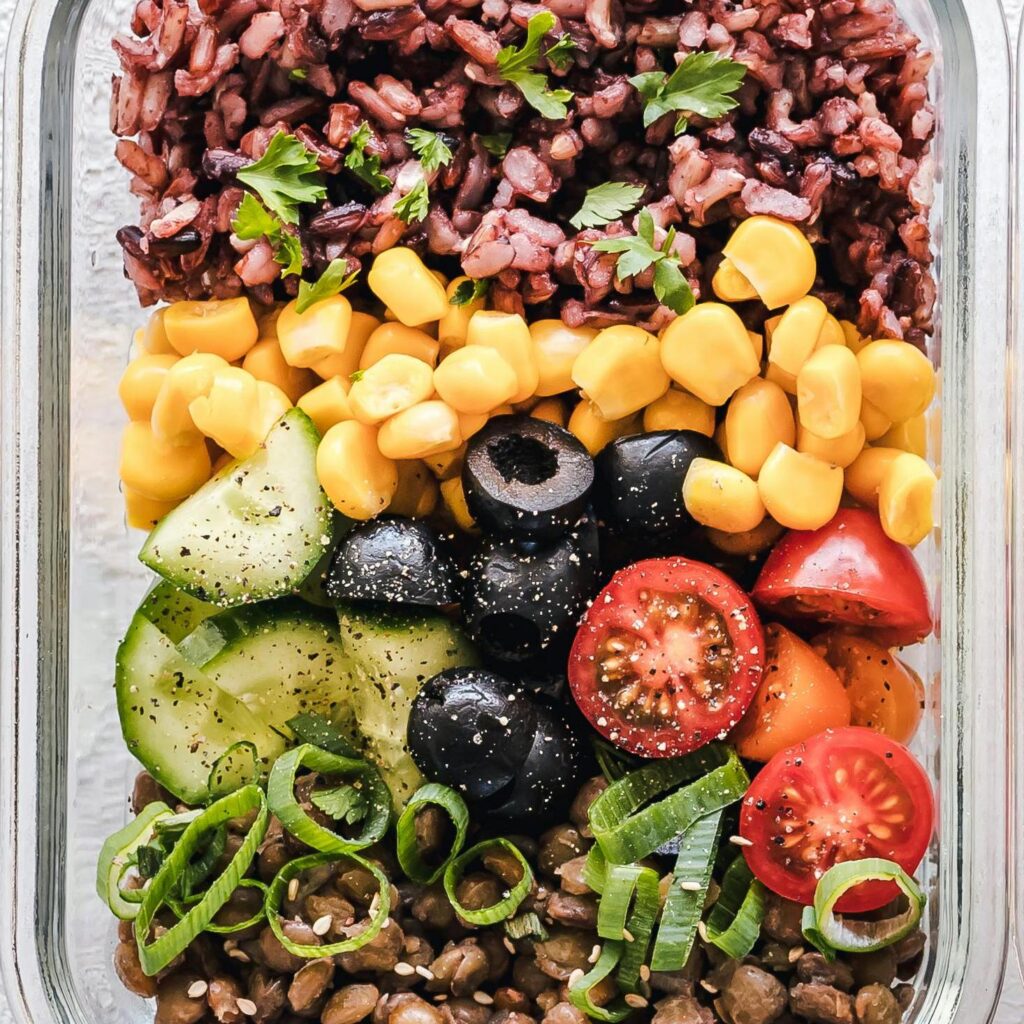Type of Carb is More Important Than How Many Carbs
This is a very important topic that always comes up in my discussions around sugar balance. The recommended daily intake of carbohydrates varies on many factors including age, sex, activity level, and overall health. If you have diabetes you may have met with a nutritionist who may have discussed a recommended amount of grams of carbs you should be eating per meal. A lot of my patients with diabetes are told to aim to stay under 45 – 60g of carb per meal or less if they are able.
However, the way I see it is that it’s not about a magic number. What it should really be about is eating in moderation and eating the right type of carbs. Things like yogurt, vegetables, fruits and milk also contain carbs. However, most of us are eating most of our carbohydrate in the form of starch and added sugars. The four types of starches are:
- Grains: Foods like rice, wheat, oats, and barley
- Legumes: Beans, lentils, and peas
- Root Vegetables: Potatoes and sweet potatoes are examples of starchy vegetables.
- Pasta and Bread: These are commonly made from wheat flour.
Out of those 4 categories, where is most of your carb consumption coming from? In my experience with patients and with my own eating I have to say that the type of starch that predominates in our diet are number 1 and 4: grains and pasta/bread respectively. Not only do we have a predilection for this type of starch, but what makes things worse is that we have it in excess and usually in its most refined/processed form. Any baked product you buy is made from refined bleached flour. White rice spikes the blood sugar because it is very refined. How can you tell if something is refined? Ask yourself does it look like it was made in a factory or did it come from the ground/farm? If it came from the ground, does it look close to what it is supposed to look like when it is harvested, or has it been significantly changed?
High Glycemic Index (70 or above):
- White bread
- White rice
- Cornflakes
- Instant rice
- Baked potatoes
- Bagels/Baguettes
- Beer
- Donuts
- French fries
- Rice milk
Moderate Glycemic Index (56-69):
- Whole wheat bread
- Brown rice
- Oatmeal
- Sweet potatoes
- Cous cous
- Muesli
- Pineapple
- Corn Chips
- Honey
- Oatmeal
- Oatmilk
- Raisins
- Rice noodles
- Corn
- Low Glycemic Index (55 or below):
- Legumes (beans, lentils)
- Quinoa
- Barley
- Taro
- Peas
- Fruits: Apples, bananas, mango, orange, grapes, grapfruit, pomelo
- Lentils
- Yogurt
- Milk
- Carrots
- Plantains
- Chickpeas
- Avocado
- Agave, maple syrup
- Peanut, peanut butter (without sugar)
- Bananas
- Soybeans
- Broccoli/cabbage/brussel sprouts
- coconut, coconut milk
- almonds, almond milk
Always try to balance your meals by including non-starchy vegetables, low carb fruits, lean proteins, healthy fats, and appropriately portioned whole grains and starchy vegetables that are low in the glycemic index. Figure out the amount of carbs, protein, and fat you can eat at meals and snacks throughout the day to keep your blood sugar levels steady. If you are going to eat a high glycemic index carb like white rice, have it with protein and a non starchy vegetable.
If you cannot make insulin you will need to administer insulin for the grams of carbs you eat so that your body can utilize the sugar when it makes it to your digestive system. If you have Type 1 diabetes (or insulin dependent Type 2 diabetes) your doctor and you will likely have come up with a “carb ratio.” This means the amount of insulin needed for the amount of carb (in grams). People that are insulin sensitive may have a carb ratio of 15 (1 unit per every 15 g of carb) and someone else who has more insulin resistance might have a carb ratio of 4 (1 unit for every 4g of carb).
Understanding how carbohydrates affect blood sugar is crucial for managing diabetes. Realize the HUGE difference between:
- Simple Carbohydrates: Foods like sugar, candy, and white bread contain simple carbohydrates that are broken down quickly, leading to a rapid increase in blood sugar levels (very high glycemic index).
- Complex Carbohydrates: Foods like whole grains, vegetables, and legumes contain complex carbohydrates, which take longer to break down. This results in a slower, more gradual increase in blood sugar levels (lower glycemic index).
When you consume carbohydrates, the digestive system breaks them down into simpler sugars, primarily glucose. This breakdown starts in the mouth with the enzyme amylase in saliva and continues in the small intestine with the help of other enzymes. In response to the rising blood glucose levels, the pancreas releases insulin, a hormone that helps cells throughout the body absorb glucose to be used for energy or stored for later use. Most of us are eating too many simple carbs and this repeated sugar spike followed by insulin spikes is what eventually leads to insulin resistance (which is the underlying cause of type 2 diabetes). Our cells need glucose for fuel. Thus, carbohydrates turning into glucose is not the problem. The problem is that we are not choosing the right carbohydrates and our society has facilitated the ease and palatability of higher glycemic index carbs. Therefore, it is up to us to be vigilant with what we put in our body on a daily basis.

 Simple Carbohydrate Plate: The bun is made with refined flour and the frying strips away the nutrients from the potatoes leading to a high simple carb meal with empty calories.
Simple Carbohydrate Plate: The bun is made with refined flour and the frying strips away the nutrients from the potatoes leading to a high simple carb meal with empty calories.
Steps for Eating Healthier Carbs
Look at labels. They make counting carbs easier. Find the “Total Carbohydrate” number listed on a package’s “Nutrition Facts” panel. Then, check the serving size and confirm the amount you will eat. Repeat this step with other foods you plan to eat. When you add all the grams of carbs, the total should stay within your meal budget. The size of one serving depends on the type of food. For instance, one small (4-ounce) piece of fresh fruit, 1/3 cup of pasta or rice, and 1/2 cup of beans are each one serving.
Drink at least 75 fl. oz. of water or non-calorie beverages per day- (seltzers ok if you crave the soda bubbly component). A rough way to calculate how much water to drink daily is to take your weight in pounds and cut it by half (75 oz if you weigh 150 lbs). Proper hydration is essential for kidney function. The kidneys play a crucial role in filtering excess glucose from the blood and excreting it through urine. Staying well-hydrated helps the kidneys perform this function more efficiently, which can help in regulating blood glucose levels. Drinking water can help with weight management by promoting a feeling of fullness and reducing appetite. Proper hydration helps maintain normal blood volume and viscosity, which can improve circulation and ensure that insulin and glucose are transported effectively to cells.
Watch your intake of high glycemic index carbs and when in doubt just ask yourself, does this look like it came from the ground or snack factory? As best you can try to avoid added sugars such as sodas, candies, baked goods, and sugary cereals. Starchy vegetables (like potatoes, corn, and peas) are also nutritious but should be eaten in moderation.
Balance your carbohydrates with protein or healthy fat (example apples with peanut butter, carrots and hummus, cheese and whole grain crackers, or a handful of nuts with a piece of fruit).
Eat more fiber: Fiber slows the digestion of carbohydrates, leading to a more gradual release of glucose into the bloodstream. This helps maintain steady blood sugar levels.
Eat more vegetables: Veggies are low in calories and high in fiber and nutrients. Non-starchy vegetables (like leafy greens, broccoli, bell peppers, and carrots) are especially good choices.
Eat carbs last: The order in which you eat it also counts. Always eat your vegetables first, protein second and carbs/sugars last.
By following these tips, you can make healthier choices when it comes to carbohydrates, supporting overall health and maintaining stable blood sugar levels whether or not you have diabetes.

